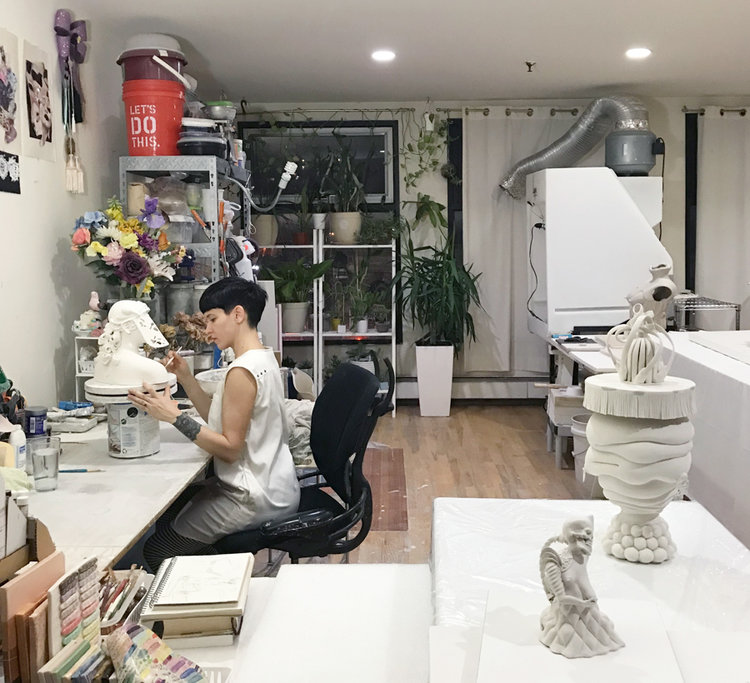Brooklyn-based sculptor Jessica Stoller is the first of four artists forming part of the interview-series “Surrealism Reloaded” – with Inka Essenhigh, Rose Nestler and Julie Curtiss to follow. Their work is equally inspired by Surrealist motives and themes. Following in the footsteps of the Fantastic Women these four artists do not only revive Surrealism but re-interpret its topics, such as femininity, from a highly contemporary perspective.
Known for her porcelain sculptures, Stoller merges female body (parts) with flora, fauna and food. The fragile, candy-colored pieces juxtapose extremes between the idealized world of femininity and the grotesque. With “female figures flaunting what they are told to hide,” Stoller is claiming power over the female body for herself–similar to her Surrealist predecessors shown in the exhibition “Fantastic Women”.
Let’s start talking a little bit about your process. What are the topics you are specifically interested in and how are they evident in your work?
In early 2020 I completed and exhibited “Bloom”, an elaborate tableau hand built from porcelain. In my sculptural practice I employ porcelain as my primary medium, mining the material’s complicated past and long held associations with beauty, desire, and taste. The still life is a sprawling arrangement of a fragmented female body amongst an anarchic spread of gaping plants, flowers, and biomorphic forms, commingling amongst fecundity and decay.
In my work I employ the ‘grotesque’ as a powerful tool to challenge patriarchal power structures, as female bodies flaunt what they are told to hide, centering on excess, hybridity, and the unseen. I create works that juxtapose extremes in content and surface, marrying the fantastical with the corporeal, the idealized with the abject, the resulting sculptures resist categorization and easy containment. To create this work, much like my other pieces, I spend copious amounts of time hand building the numerous forms, this is done by coiling, carving, sculpting, piping, and molding the clay, firing the pieces multiple times to create richly colored surfaces through a combination of colored glazes and china paints.
I see! The morphing of nature and the human body, creating hybrids, exploring the natural world, and fighting for emancipation were all themes of the women Surrealists. What does Surrealism mean for you and what kind of role does it play in your work?
Surrealism offers an alternative way of seeing the world through an uncanny lens. An experience with a surreal work can create powerful new sensations within one’s self, cracking open static norms, breaking the boundaries of perceived order and reason while simultaneously allowing a magical alchemy to invent the new. In my work I use the surreal as a visual language to blur boundaries, invert hierarchy, and conjure the unseen by creating forms that delight and repulse in equal measure.
If you had to pick one, which artist from the Fantastic Women exhibition feels closest to you?
That is an impossibly hard question as the show is entirely composed of exceptional artists. If I had to choose, I would say Leonor Fini’s work and life resonates and inspires me most. Fini was truly groundbreaking, mining her own pleasure and power as material in both her life and art. I‘m captivated by her revolutionary exploration of the malleability of sexuality, gender, mythology, and fantasy. In her personal and professional life she refused to follow the rules and limiting societal conventions of her time, avoiding art school to instead learn to draw from the morgue and declining the label of a surrealist as women were expected to be passive muses.
Yes, the female body was a topic in Leonor Fini’s work. Among other women artists, she aimed to liberate herself from the predominant male gaze. This topic is also an integral part of your work. Why?
The female body is an integral part of my work because I am a woman and it shapes my experience and serves as continual fodder for me. From understanding its primordial power to its ongoing subjugation, the female body is such a potent site for the intersection of culture, nature, and religion, it is undoubtedly a site for oppression, but also liberation and imagination.

Female friendships and networks were vital for the women artists in the 30s and 40s. You’re also pretty active on social media, do you think Instagram is the new salon for the female squad?
I am a late and somewhat critical adopter to Instagram. It has benefits, connecting people and allowing artists to easily support, exchange, and promote their work. However, this is all more topical in nature to me. In 2006 a close friend from graduate school started a crit group of female artists from school. The group has waxed and waned but we continue to go strong 10+ years later, meeting for studio visits to provide feedback and critical dialogue which can often be hard to come by post school. Communing in person and going in depth with these other artists is where I feel the most meaning and value–they are my squad.
That sounds great! Last question, and since we’re still in a very special situation due to the corona crisis right now: How has the lockdown changed your work?
The quarantine has definitely had an impact on my work. It is still unfolding, and we are in the midst of it, so it is hard to have perspective while being submerged. I feel unmoored but am focusing on research and development of new work. I also teach ceramics and as our semester has been moved online, I have been devoting copious amounts of time and energy to my teaching, trying to connect, share, and inspire my students while we navigate this upside down time.
